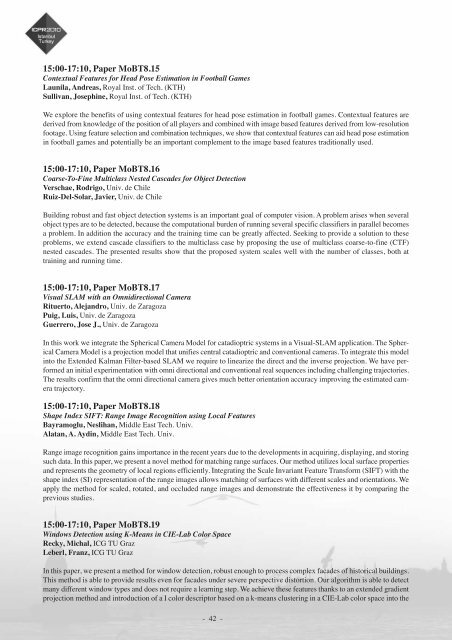Abstract book (pdf) - ICPR 2010
Abstract book (pdf) - ICPR 2010
Abstract book (pdf) - ICPR 2010
- TAGS
- abstract
- icpr
- icpr2010.org
You also want an ePaper? Increase the reach of your titles
YUMPU automatically turns print PDFs into web optimized ePapers that Google loves.
15:00-17:10, Paper MoBT8.15<br />
Contextual Features for Head Pose Estimation in Football Games<br />
Launila, Andreas, Royal Inst. of Tech. (KTH)<br />
Sullivan, Josephine, Royal Inst. of Tech. (KTH)<br />
We explore the benefits of using contextual features for head pose estimation in football games. Contextual features are<br />
derived from knowledge of the position of all players and combined with image based features derived from low-resolution<br />
footage. Using feature selection and combination techniques, we show that contextual features can aid head pose estimation<br />
in football games and potentially be an important complement to the image based features traditionally used.<br />
15:00-17:10, Paper MoBT8.16<br />
Coarse-To-Fine Multiclass Nested Cascades for Object Detection<br />
Verschae, Rodrigo, Univ. de Chile<br />
Ruiz-Del-Solar, Javier, Univ. de Chile<br />
Building robust and fast object detection systems is an important goal of computer vision. A problem arises when several<br />
object types are to be detected, because the computational burden of running several specific classifiers in parallel becomes<br />
a problem. In addition the accuracy and the training time can be greatly affected. Seeking to provide a solution to these<br />
problems, we extend cascade classifiers to the multiclass case by proposing the use of multiclass coarse-to-fine (CTF)<br />
nested cascades. The presented results show that the proposed system scales well with the number of classes, both at<br />
training and running time.<br />
15:00-17:10, Paper MoBT8.17<br />
Visual SLAM with an Omnidirectional Camera<br />
Rituerto, Alejandro, Univ. de Zaragoza<br />
Puig, Luis, Univ. de Zaragoza<br />
Guerrero, Jose J., Univ. de Zaragoza<br />
In this work we integrate the Spherical Camera Model for catadioptric systems in a Visual-SLAM application. The Spherical<br />
Camera Model is a projection model that unifies central catadioptric and conventional cameras. To integrate this model<br />
into the Extended Kalman Filter-based SLAM we require to linearize the direct and the inverse projection. We have performed<br />
an initial experimentation with omni directional and conventional real sequences including challenging trajectories.<br />
The results confirm that the omni directional camera gives much better orientation accuracy improving the estimated camera<br />
trajectory.<br />
15:00-17:10, Paper MoBT8.18<br />
Shape Index SIFT: Range Image Recognition using Local Features<br />
Bayramoglu, Neslihan, Middle East Tech. Univ.<br />
Alatan, A. Aydin, Middle East Tech. Univ.<br />
Range image recognition gains importance in the recent years due to the developments in acquiring, displaying, and storing<br />
such data. In this paper, we present a novel method for matching range surfaces. Our method utilizes local surface properties<br />
and represents the geometry of local regions efficiently. Integrating the Scale Invariant Feature Transform (SIFT) with the<br />
shape index (SI) representation of the range images allows matching of surfaces with different scales and orientations. We<br />
apply the method for scaled, rotated, and occluded range images and demonstrate the effectiveness it by comparing the<br />
previous studies.<br />
15:00-17:10, Paper MoBT8.19<br />
Windows Detection using K-Means in CIE-Lab Color Space<br />
Recky, Michal, ICG TU Graz<br />
Leberl, Franz, ICG TU Graz<br />
In this paper, we present a method for window detection, robust enough to process complex facades of historical buildings.<br />
This method is able to provide results even for facades under severe perspective distortion. Our algorithm is able to detect<br />
many different window types and does not require a learning step. We achieve these features thanks to an extended gradient<br />
projection method and introduction of a I color descriptor based on a k-means clustering in a CIE-Lab color space into the<br />
- 42 -



